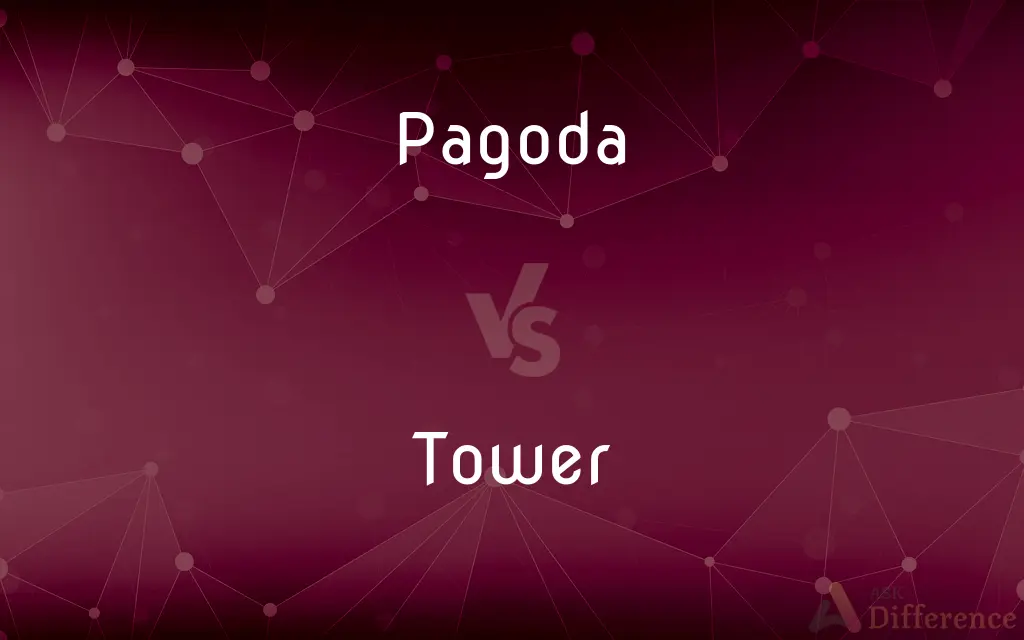Pagoda vs. Tower — What's the Difference?
By Fiza Rafique & Urooj Arif — Updated on April 15, 2024
Pagodas are tiered structures typically associated with religious or spiritual use in Asian cultures, featuring multiple eaves; towers are vertical structures used for various purposes including observation, and defense, without the strict styles.

Difference Between Pagoda and Tower
Table of Contents
ADVERTISEMENT
Key Differences
Pagodas often serve religious or spiritual purposes in Asian cultures, characterized by their multi-tiered architecture and traditional ornamental designs. On the other hand, towers are utilized for a variety of functions including observation, communication, and defense, and can be found in many different styles depending on their purpose and location.
The architectural style of pagodas usually includes multiple stacked roofs that create a tiered effect, which is believed to harmonize with spiritual or natural elements. Whereas towers tend to have a more uniform exterior, focusing on height and structural efficiency rather than symbolic design.
Pagodas are predominantly found in countries like China, Japan, Korea, and throughout Southeast Asia, reflecting Buddhist and Taoist influences. In contrast, towers are a global phenomenon, seen in modern cities and historic sites worldwide, serving both practical and aesthetic purposes.
Material usage in pagodas traditionally involves wood, which allows flexibility during earthquakes, contributing to their durability. Conversely, towers are constructed from a variety of materials including stone, brick, steel, and glass, chosen for their strength and suitability to height and weather conditions.
Culturally, pagodas are seen as symbols of peace and spirituality, often situated in temple complexes or gardens. Towers, however, are often viewed as symbols of modernity and power, prominently featured in city skylines and military fortifications.
ADVERTISEMENT
Comparison Chart
Purpose
Primarily spiritual or religious
Varied: defense, communication, observation
Style
Tiered with multiple eaves
Often uniform, focused on height
Location
Predominantly in Asia
Worldwide
Materials
Mainly wood
Stone, brick, steel, glass
Cultural Symbolism
Peace, spirituality
Modernity, power
Compare with Definitions
Pagoda
A structure with multiple eaves, built in a tradition that is particularly East Asian.
The garden's center was marked by a small pagoda, a serene spot for meditation.
Tower
A high structure used for transmitting signals or communications.
The radio tower broadcasts signals across the entire city.
Pagoda
Any of various tower-like buildings in Asia, used for religious purposes.
Pilgrims gathered at the ancient pagoda to celebrate the full moon.
Tower
A tall structure that may serve as an observation point, part of a castle, or for other uses.
The watch tower at the castle's corner provided a perfect view of the approaching enemy.
Pagoda
A tower with an upward curving roof.
The museum's new exhibit featured a model of a traditional Korean pagoda.
Tower
A strong vertical structure, often part of defensive buildings.
The medieval tower was built with stone walls three feet thick.
Pagoda
A building resembling a tower, steeped in cultural and religious significance in Asia.
The old pagoda on the hill has been a place of worship for centuries.
Tower
A modern structure noted for its height and architectural distinctiveness.
The new office tower is a marvel of contemporary design.
Pagoda
A multi-tiered tower in Asian architecture, typically associated with religious buildings.
The pagoda at the temple stood five stories high, each level intricately carved.
Tower
Part of a building especially high and noticeable.
The downtown skyline is dominated by the glass tower of the corporate headquarters.
Pagoda
A pagoda is a tiered tower with multiple eaves common to China, Japan, Korea, Vietnam and other parts of Asia. Most pagodas were built to have a religious function, most often Buddhist but sometimes Taoist, and were often located in or near viharas.
Tower
A tower is a tall structure, taller than it is wide, often by a significant factor. Towers are distinguished from masts by their lack of guy-wires and are therefore, along with tall buildings, self-supporting structures.
Pagoda
(in India and East Asia) a Hindu or Buddhist temple, typically in the form of a many-tiered tower.
Tower
A tall, narrow building, either free-standing or forming part of a building such as a church or castle
The south-west tower is a wonderful example of late Gothic
Pagoda
A religious building of East Asia and Southeast Asia, especially a multistory Buddhist tower with overhanging eaves separating each level, erected as a memorial or shrine.
Tower
A tall structure that houses machinery, operators, etc.
A control tower
Pagoda
A stupa.
Tower
Rise to or reach a great height
He seemed to tower over everyone else
Pagoda
A structure, such as a garden pavilion, built in imitation of a multistory Buddhist tower.
Tower
(of a bird) soar to a great height, especially (of a falcon) so as to be able to swoop down on the quarry.
Pagoda
A religious building in South and Southeast Asia, especially a multi-storey tower erected as a Hindu or Buddhist temple.
Tower
A building or part of a building that is exceptionally high in proportion to its width and length.
Pagoda
An image or carving of a god in South and Southeast Asia; an idol.
Tower
A tall, slender structure used for observation, signaling, or pumping.
Pagoda
A unit of currency, a coin made of gold or half gold, issued by various dynasties in medieval southern India.
Tower
One that conspicuously embodies strength, firmness, or another virtue.
Pagoda
An ornamental structure imitating the design of the religious building, erected in a park or garden.
Tower
(Computers) A computer system whose components are arranged in a vertical stack and housed in a tall, narrow cabinet.
Pagoda
(rare) A pagoda sleeve.
Tower
To appear at or rise to a conspicuous height; loom
"There he stood, grown suddenly tall, towering above them" (J.R.R. Tolkien).
Pagoda
A term by which Europeans designate religious temples and tower-like buildings of the Hindoos and Buddhists of India, Farther India, China, and Japan, - usually but not always, devoted to idol worship.
Tower
To fly directly upward before swooping or falling. Used of certain birds.
Pagoda
An idol.
Tower
To demonstrate great superiority; be preeminent
Towers over other poets of the day.
Pagoda
A gold or silver coin, of various kinds and values, formerly current in India. The Madras gold pagoda was worth about three and a half rupees.
Tower
A very tall iron-framed structure, usually painted red and white, on which microwave, radio, satellite, or other communication antennas are installed; mast.
Pagoda
An Asian temple; usually a pyramidal tower with an upward curving roof
Tower
A similarly framed structure with a platform or enclosed area on top, used as a lookout for spotting fires, plane crashes, fugitives, etc.
Tower
A water tower.
Tower
A control tower.
Tower
Any very tall building or structure; skyscraper.
The Sears Tower
Tower
(figuratively) An item of various kinds, such as a computer case, that is higher than it is wide.
Tower
(informal) An interlocking tower.
Tower
(figurative) A strong refuge; a defence.
Tower
(historical) A tall fashionable headdress worn in the time of King William III and Queen Anne.
Tower
(obsolete) High flight; elevation.
Tower
The sixteenth trump or Major Arcana card in many Tarot decks, usually deemed an ill omen.
Tower
(cartomancy) The nineteenth Lenormand card, representing structure, bureaucracy, stability and loneliness.
Tower
One who tows.
Tower
(intransitive) To be very tall.
The office block towered into the sky.
Tower
(intransitive) To be high or lofty; to soar.
Tower
To soar into.
Tower
A mass of building standing alone and insulated, usually higher than its diameter, but when of great size not always of that proportion.
Tower
A citadel; a fortress; hence, a defense.
Thou hast been a shelter for me, and a strong tower from the enemy.
Tower
A headdress of a high or towerlike form, fashionable about the end of the seventeenth century and until 1715; also, any high headdress.
Lay trains of amorous intriguesIn towers, and curls, and periwigs.
Tower
High flight; elevation.
Tower
To rise and overtop other objects; to be lofty or very high; hence, to soar.
On the other side an high rock towered still.
My lord protector's hawks do tower so well.
Tower
To soar into.
Tower
A structure taller than its diameter; can stand alone or be attached to a larger building
Tower
Anything tall and thin approximating the shape of a column or tower;
The test tube held a column of white powder
A tower of dust rose above the horizon
A thin pillar of smoke betrayed their campsite
Tower
A powerful small boat designed to pull or push larger ships
Tower
Appear very large or occupy a commanding position;
The huge sculpture predominates over the fountain
Large shadows loomed on the canyon wall
Common Curiosities
Can towers have a religious significance?
Yes, some towers, like bell towers or minarets, hold religious significance.
What architectural style defines a pagoda?
Pagodas are defined by their tiered, multi-eaved design.
Do all towers serve a practical purpose?
Most towers have practical purposes, but some may also be purely decorative.
Which is typically taller, a pagoda or a tower?
Towers are typically taller than pagodas.
What is the primary purpose of a pagoda?
Pagodas are primarily used for spiritual or religious purposes.
What is a key visual feature of pagodas?
A key feature of pagodas is their multiple eaves and tiers.
How do construction materials differ between pagodas and towers?
Pagodas traditionally use a lot of wood, while towers use more durable materials like steel and concrete.
What materials are commonly used to build towers?
Towers are often built with materials like steel, glass, and brick.
Are pagodas found outside Asia?
Yes, pagodas can be found outside Asia, often within Asian cultural gardens or architectural museums.
Do pagodas play a cultural role in societies?
Yes, pagodas play significant cultural and spiritual roles in Asian societies.
Can both pagodas and towers withstand natural disasters?
Both structures can be designed to withstand natural disasters, but materials and construction methods vary significantly.
How do the purposes of pagodas and towers differ?
Pagodas generally serve religious functions, while towers have varied uses including defense and communication.
Are there modern pagodas being built today?
Yes, modern pagodas are built, especially in places with cultural ties to traditional pagoda architecture.
What cultural symbolism is associated with towers?
Towers often symbolize modernity and technological advancement.
Is there a difference in the global distribution of pagodas and towers?
Yes, pagodas are mainly located in Asia, while towers are found globally.
Share Your Discovery

Previous Comparison
However vs. Whereas
Next Comparison
Grandpa vs. GrandfatherAuthor Spotlight
Written by
Fiza RafiqueFiza Rafique is a skilled content writer at AskDifference.com, where she meticulously refines and enhances written pieces. Drawing from her vast editorial expertise, Fiza ensures clarity, accuracy, and precision in every article. Passionate about language, she continually seeks to elevate the quality of content for readers worldwide.
Co-written by
Urooj ArifUrooj is a skilled content writer at Ask Difference, known for her exceptional ability to simplify complex topics into engaging and informative content. With a passion for research and a flair for clear, concise writing, she consistently delivers articles that resonate with our diverse audience.














































